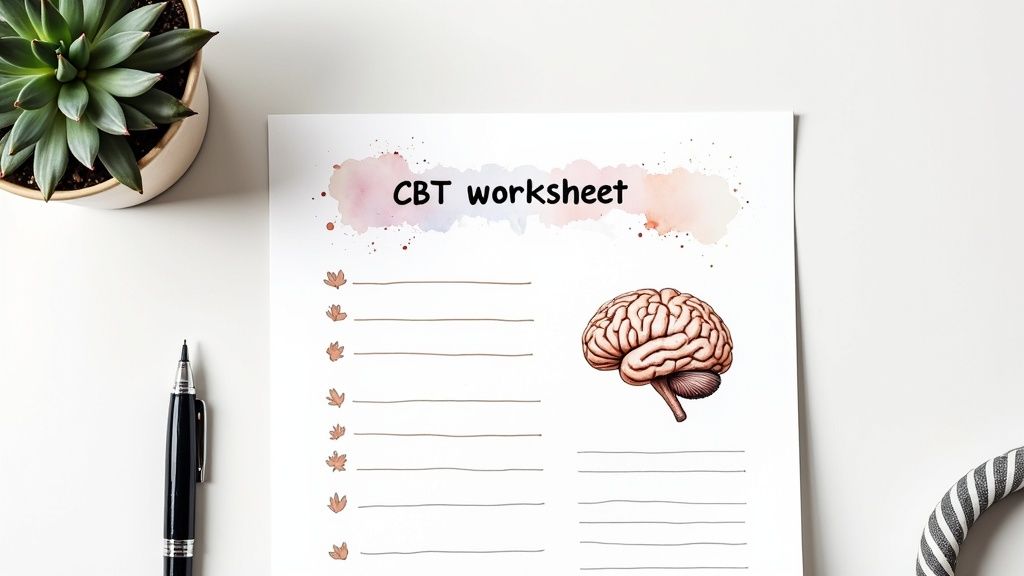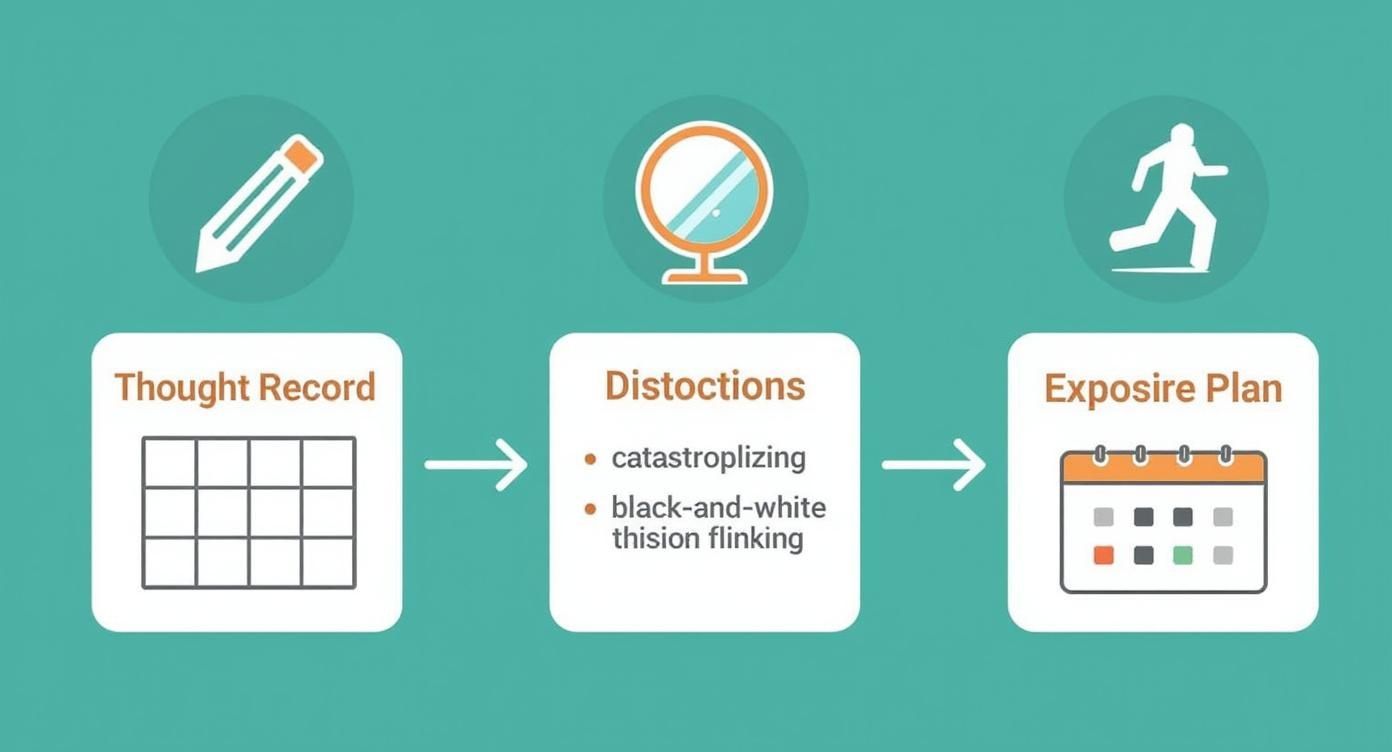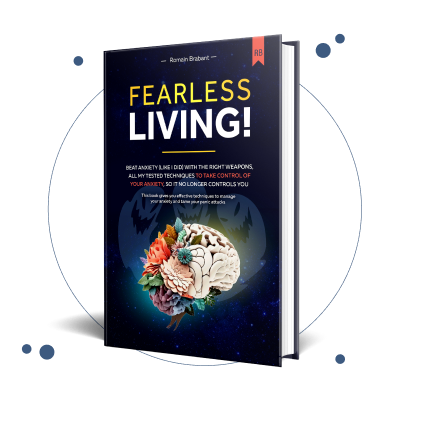
Ready to take the first step toward a calmer, more controlled, and panic-free life? You’ve arrived at exactly the right place. Cognitive behavioral therapy worksheets pdf serve as hands-on, step-by-step guides that shine a light on the thought loops driving your anxiety—and point you straight toward lasting relief and resilience. This is where your journey to healing begins.
Your Path to a Calmer Mind Starts Here

Feeling trapped by racing thoughts or sudden panic? You’re not alone, and it's important to know that this feeling doesn't have to be permanent. While anxiety can make you feel stuck, there is a proven way out. At its core, this guide offers one clear message of hope: you have the capacity to heal and reclaim a life of peace and freedom.
Anxiety often operates through well-worn mental shortcuts—automatic reactions your brain takes without a second thought. Imagine these as old, overgrown trails in a forest. Cognitive Behavioral Therapy (CBT) worksheets act like a map and pruning shears, giving you the power to:
- Spot the winding paths of worry
- Understand why those routes became so familiar
- Carve out new, peaceful trails in your thinking
These worksheets aren’t just print-outs. They are your personal toolkit for building a future where you are in control, not your anxiety.
A Proven Framework for Lasting Change
Putting pen to paper with these worksheets is more than a hopeful exercise—it’s an evidence-backed process for healing. Consider the data from a comprehensive meta-analysis:
- 42% of patients respond positively to CBT
- 36% achieve full symptom remission
- 63.64% maintain that remission over the long term
These figures aren't just statistics; they are proof that a life free from the constant burden of anxiety is achievable.
These structured exercises provide a tangible way to externalize your thoughts, moving them from the chaotic space inside your mind to a clear, manageable format on paper. This simple act is the first hopeful step toward regaining a sense of control and calm.
As you work through each worksheet, you’ll gradually retrain your brain’s stress responses. You’ll learn to:
- Challenge automatic negative thoughts
- Replace them with balanced, realistic perspectives
- Reinforce new, healthier thinking patterns with each session
If you’d like to dive deeper into the theories behind CBT, check out foundational psychology resources. And for extra guidance on how CBT fits into a broader anxiety-treatment plan, our exploration of psychotherapy for anxiety offers valuable insights.
How CBT Worksheets Help Rewire Your Brain for Peace

It can feel like anxiety is hardwired into your brain—an automatic switch that flips without your permission. But what if you could get your hands on the control panel and start changing the wiring yourself? That's exactly what Cognitive Behavioral Therapy worksheets are designed to empower you to do. This is not about just coping; it's about genuine, lasting healing.
Think of your mind as a garden where anxious thoughts are like fast-growing weeds. For years, they may have grown unchecked, creating deep, tangled roots that feel permanent. A cognitive behavioral therapy worksheets pdf is your go-to gardening tool. It helps you see the weeds clearly, understand how they grow, and gently uproot them one by one, making space for peace to flourish.
This process works because of the powerful, direct link between your thoughts, feelings, and actions. An anxious thought is never just a passing idea; it triggers a very real emotional and physical response. Using worksheets consistently interrupts this automatic cycle, giving you a structured way to practice and build healthier mental habits.
Building New Mental Pathways to a Panic-Free Life
Every single time you fill out a worksheet, you’re actively carving a new neural pathway in your brain—a pathway toward calm. At first, this new path might feel strange and overgrown, like hacking your way through a dense forest. Meanwhile, the old, familiar trail of anxiety is wide and easy to follow.
But with repetition, that new path gets clearer. It becomes easier and more natural to navigate. Hope is not a passive feeling; it's built through these small, consistent actions.
This isn't just a metaphor—it’s a process known as neuroplasticity. Your brain has a remarkable, built-in ability to reorganize itself by forming new connections. CBT worksheets provide the structured practice that encourages and reinforces these healthier, calmer connections, proving that change is always possible.
This practice empowers you to build a more resilient mindset, one where you're in the driver's seat. It's a journey of transforming your brain’s default responses from panic to peace. To dig deeper into how this all works, our guide on understanding CBT for anxiety is a great place to start.
The Science of Hopeful Action
The simple act of writing down a negative thought and challenging it creates a profound shift. It moves you from being a passive victim of your anxiety to an active participant in your own healing. This is where real, lasting change begins, and it is entirely within your reach.
With each worksheet you complete, you're gathering concrete evidence that you can handle difficult thoughts and emotions. This builds self-trust and reinforces the core message of hope in CBT: your thoughts are not undeniable facts. You have the power to examine them, question their validity, and choose a more balanced perspective.
This gradual, intentional process of rewiring is the key to living a life that isn't dictated by constant panic. It’s about more than just managing symptoms; it’s about fundamentally changing your relationship with your own mind. You learn that healing isn’t some distant dream—it's a skill you can build, one worksheet at a time.
Essential CBT Worksheets for Anxiety and Panic
So, we've talked about the "why" behind CBT. Now it’s time to get practical and look at the "how"—the actual tools that can make a profound difference in your day-to-day life. Think of these worksheets as your roadmap out of the storm, each one built to target a specific piece of the anxiety puzzle.
When you’re stuck in a cycle of anxiety and panic, it can feel like you're lost without a compass. These worksheets are your instruments. They give you a way to find your bearings, untangle the chaotic thoughts fueling your distress, and finally chart a course toward the calm life you deserve.
Your Guide to Core CBT Worksheets for Anxiety
To get you started, here’s a quick rundown of the most common and effective CBT worksheets. Think of this as your field guide—a map to help you choose the right tool for the right moment. Each worksheet offers a structured, hopeful path to tackle the patterns that keep anxiety going.
| Worksheet Type | Primary Goal | Best For |
|---|---|---|
| Thought Record | Identify & challenge automatic negative thoughts | Untangling specific stressful events |
| Cognitive Distortions | Recognize unhelpful thinking patterns | Pinpointing mental habits like catastrophizing |
| Behavioral Activation | Increase positive activities & reduce avoidance | Overcoming withdrawal and low motivation |
| Exposure Hierarchy | Gradually face feared situations | Tackling phobias and social anxiety |
| Worry Script | Contain and process chronic worry | Managing Generalized Anxiety Disorder (GAD) |
These are just a few of the core tools, but they provide a powerful foundation for anyone looking to build resilience and live a life free from panic. Let's dive a little deeper into two of the most essential ones.
The Thought Record: Your Personal Anxiety Detective
If there's one tool that forms the bedrock of CBT, it’s the Thought Record. Its main job is to turn you into a detective of your own mind. It helps you slow down and map out the connection between a situation, the automatic thought it triggers, and the feelings and behaviors that follow.
Let's say you get a vague text from your boss: "We need to talk tomorrow." Your mind might immediately jump to the worst.
- Automatic Thought: "Oh no, I'm getting fired."
- Feeling: A pit of dread in your stomach, intense fear.
- Behavior: You spend the rest of the night replaying every mistake you've ever made, unable to sleep.
A Thought Record gives you specific columns to write all of this down. But here’s the most empowering part: it also gives you space to challenge that automatic thought. You can look for evidence for and against it, and then come up with a more balanced alternative, like, "It could be about a new project, or maybe it’s just a routine check-in." This simple act breaks the panic cycle right in its tracks.
Identifying Unhelpful Thinking Styles
Another must-have tool is the Cognitive Distortions worksheet. Think of this one as a field guide to all the common mental traps—like catastrophizing, black-and-white thinking, or mind-reading—that keep us stuck in anxiety. Just being able to name these patterns is the first step toward disarming their power.
When you can identify your go-to distortions, you start seeing them for what they are: mental habits, not undeniable facts. This creates a sliver of space between you and the thought, giving you the power to choose a different response. You start to realize that a thought is just a thought, not a perfect reflection of reality. This is an absolutely crucial skill for anyone wanting to learn how to manage the symptoms of a panic attack and move toward a panic-free life.
The real power of these worksheets is in making the internal external. When a worry is trapped inside your head, it feels enormous and unquestionably true. Writing it down puts it on paper, turning it into something visible and manageable. It robs the thought of its immediate power.
This isn't just a nice idea; it's a well-established practice. In a UK survey, 80% of psychological practitioners reported using CBT workbooks to help their clients make their internal experiences more concrete. They found that putting thoughts into a "black and white" format is a key step toward being able to evaluate and defuse them. You can check out the full findings on how workbooks support therapy.
These tools aren't about magically eliminating anxiety for good. They're about building the skills to manage it, day in and day out. They give you concrete, repeatable actions to reclaim control and offer real hope that a life free from the grip of panic is entirely possible. Every worksheet you complete is another step toward that freedom.
How to Use Your First Thought Record
Opening up your first Thought Record can feel a little like trying to read a foreign language. It's one of the most powerful tools in the CBT toolkit, but it can look intimidating at first glance.
This walkthrough is designed to take the mystery out of it and give you the confidence to start talking back to your anxiety. Think of it less like filling out a form and more like having a structured, eye-opening conversation with yourself—one that leads to healing.
Let’s walk through a common scenario to see how it works. Imagine you just got invited to a party for this coming weekend, and your anxiety instantly spikes. Instead of getting swept away by the worry, you grab your Thought Record.
Step 1: Capture the Situation and Your Feelings
First things first, you just get the facts down on paper. What happened? And how, exactly, did it make you feel? Be specific about the event itself, then rate the intensity of each emotion you’re feeling.
- Situation: "My friend invited me to a party on Saturday night where I won't know many people."
- Feelings/Emotions: Write down the main emotions and give them a score from 0-100%. For example: Anxiety (90%), Dread (75%), Awkwardness (80%).
This simple act takes the problem out of the chaotic swirl in your head and pins it down on the page. It’s the first step to getting a foothold and starting to feel in control again.
Step 2: Identify the Automatic Negative Thought
Next, you’re going to pinpoint the automatic negative thought (ANT) that flashed through your mind. This is the thought that kicked off all those intense feelings. It’s usually a snap judgment, a harsh prediction, or a self-critical jab.
- Automatic Negative Thought: "I’m going to be so awkward. Everyone will think I'm weird and I'll end up standing alone all night."
This one thought is the engine driving your anxiety. The rest of the worksheet is all about carefully taking that engine apart.
Step 3: Find Your Cognitive Distortions
This is where you put on your detective hat. Automatic thoughts aren't random; they're usually powered by common thinking errors called cognitive distortions. Learning to spot them helps you realize your thought isn't a fact—it's just a faulty mental habit that you can change.
The goal isn’t to scold yourself for having these thoughts, but to recognize the patterns with gentle curiosity. Naming the distortion (like "Mind Reading" or "Catastrophizing") separates you from the thought and drains its power.
You can get familiar with these common mental traps by checking out this guide on cognitive distortions. In our party example, the distortions running the show include:
- Mind Reading: Assuming you know what other people are thinking ("Everyone will think I'm weird").
- Fortune Telling: Predicting a negative outcome as if it's a certainty ("I'll end up standing alone").
- Catastrophizing: Blowing things out of proportion and imagining the worst-case scenario.
This infographic shows how identifying thoughts and distortions fits into the bigger picture of using CBT worksheets.

Seeing the flow from one tool to the next helps you understand that each worksheet is building on the last, giving you a new skill for handling anxiety and creating a more peaceful life.
Step 4: Create a Balanced, Alternative Thought
Finally, it's time to challenge that automatic thought by coming up with a more balanced and realistic alternative. This isn’t about forcing yourself to be positive; it’s about finding a more rational, believable middle ground that feels true.
- Balanced Thought: "I might feel awkward at first, and that's okay. I can't know for sure what people will think, but I can focus on talking to the friend who invited me. I've been to parties before and made it through, and I can always leave if I'm not feeling it."
Now, take a moment to re-rate your emotions. You'll probably find that your Anxiety has dropped to 50% and the Dread is down to 30%. This is the process in action. It's a skill you can practice and repeat, offering a clear, hopeful path toward a life that isn't run by panic.
Integrating Digital CBT Tools into Your Life
There’s something incredibly powerful about putting pen to paper. The focused, reflective nature of a worksheet can help untangle the messiest of thoughts. But let’s face it, we now have more tools available than ever before to support our healing journey.
The brilliant principles behind a cognitive behavioral therapy worksheets pdf are no longer stuck on printable pages. They’ve gone digital, living in apps and platforms on our phones. This opens up new ways to build a consistent, effective practice that actually fits into your modern life.
The goal is exactly the same: to give you a structured way to understand and reshape your thoughts, clearing a real path to a panic-free life. Whether you prefer a physical worksheet or a digital tool often comes down to your personal style. One person might find clarity in the slow, deliberate act of writing, while another thrives on the convenience and tracking features of an app.
From Paper PDFs to Pocket Tools
Moving to digital formats isn't just about ditching the printer; it's about accessibility and consistency. Having CBT tools on your phone means you can capture and challenge an anxious thought the moment it happens, turning a moment of distress into an opportunity for healing.
It doesn’t matter if you're on the bus, stuck in a boring meeting, or waiting in line for coffee. You can pull out your phone and do the work right then and there.
This shift isn't just a trend. Research has shown the significant potential of digital CBT tools, highlighting advantages like perfect legibility (no more deciphering your own handwriting!), easy sharing with a therapist, and a dynamic nature that paper just can’t compete with.
The most important factor isn’t the format you choose—it's the consistency you build. Every time you engage with a CBT exercise, digital or physical, you are casting a vote for a calmer future and reinforcing the belief that you can heal.
What to Look For in a Digital CBT App
As you start exploring digital options, you’ll quickly realize that not all mental health apps are created equal. It's crucial to pick tools that are actually grounded in proven therapeutic principles that support genuine healing.
Here are a few key things to look for:
- Evidence-Based: Does the app openly state that it uses established CBT techniques like thought records and cognitive restructuring? It should.
- User-Friendly Design: Is the app's interface intuitive and calming, or does it feel cluttered and add to your stress? The last thing you need is a tool that makes you more anxious.
- Privacy-Focused: Your mental health data is deeply personal and sensitive. Look for a clear, strong privacy policy that tells you exactly how your information is handled.
- Guided Structure: Does it offer more than just a blank digital journal? The best tools provide structure and guidance, much like our programs at Anxiety University, to walk you through the process step-by-step.
Ultimately, the best tool is the one you will actually use. Whether you stick with a printable PDF or find an app that clicks with you, integrating these practices into your daily routine is a profound act of hope—and a tangible step toward lasting freedom from anxiety.
Common Questions About Using CBT Worksheets
Starting with CBT worksheets is a big step, and it’s totally normal to have questions. You might even feel a little skeptical. That's okay. This is your space to get clear, straightforward answers that will build your confidence.
Think of it like learning to play an instrument. Your first few attempts might feel clumsy—you won't be playing a perfect song right away. But if you stick with it, even just a little bit each day, you'll start to hear the music. Every worksheet you fill out is a hopeful step toward a life with less anxiety and more you.
How Soon Will I Feel Better Using These Worksheets?
This is the big question, isn't it? While everyone's timeline is different, most people feel a subtle shift within a few weeks. It’s not necessarily that the anxiety is gone, but something else clicks into place: a sense of hope and control. You’re finally doing something about it, and that feeling alone is a huge relief.
Real, noticeable change usually builds over several weeks to months. You're essentially retraining your brain's default reactions, and just like building muscle at the gym, that takes time and consistency. Be patient and compassionate with yourself. Healing is a journey, not a race.
The goal here is consistency, not perfection. You don't have to fill out every worksheet flawlessly. Just keep showing up for yourself. Celebrate the small wins, like catching one automatic thought or questioning one distortion. Those are the moments that build a panic-free life.
Can I Use These Worksheets Without a Therapist?
Absolutely. One of the most empowering things about a cognitive behavioral therapy worksheets pdf is that it's designed for you to use on your own. You can start right now and begin to understand the patterns that have been keeping you stuck. Think of them as your personal roadmap to your own mind, guiding you toward peace.
That said, working with a therapist can accelerate your healing. If you feel stuck, are up against some really stubborn thought patterns, or just want that extra layer of support, a therapist can help you get the most out of every single exercise and offer guidance tailored just for you.
What if I Fill Out a Worksheet and Still Feel Anxious?
First off, this is completely normal and part of the process. A worksheet isn't a magic wand that instantly zaps anxiety away. Its real job is to help you build a new, more resilient way of thinking for the long haul.
Sometimes, looking an anxious thought in the face can actually make you feel it more intensely for a moment. But here’s the secret: the win isn't in making the feeling disappear. The win is the fact that you did the exercise. You identified the thought, you questioned it, and you took a powerful step toward a different response. You just proved to yourself that you are stronger than the anxiety.
- Notice the feeling without judging it.
- Remind yourself you're learning a new skill.
- Give yourself credit for taking a constructive, hopeful step.
Healing isn’t about never feeling anxious again. It’s about knowing you have the tools and the strength to handle it when it does show up. That knowledge is where true, lasting peace comes from.
Where Can I Find Trustworthy CBT Worksheets to Download?
With so much online, it’s smart to be picky. The most reliable worksheets come from reputable sources like mental health organizations, university psychology departments, and government health institutes. They offer materials grounded in real science, and they're almost always free.
Be wary of sites that make flashy, unrealistic promises or charge a lot for simple PDFs. The power isn't in the design; it's in the proven CBT framework that offers a real path to healing. You've got this, and with the right tools, you're already on your way to a calmer, more joyful life.
At The Anxiety Checklist, we've built a complete system to guide you through this process. Our Fearless Living program pairs practical, easy-to-use worksheets with a detailed eBook, giving you everything you need to understand and manage anxiety. It's time to build your toolkit for a panic-free future.
Find your path to fearless living at https://anxietychecklist.com.

